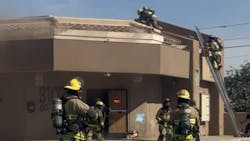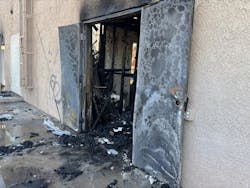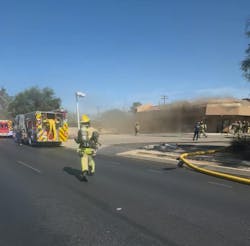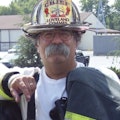Close Calls: Lack of Consideration of Flow Path Puts Firefighters in Danger
Key Takeaways
- Delayed response, lack of initial 360-degree size-up and risk/benefit analysis, and poor flow path management put firefighters in danger at a fire at an abandoned gas station.
- Every effort must be put in to ensuring that a size-up at a structure or building fire is 360 degrees.
- The best first-alarm assignments dispatch all of the predictable resources, including mutual aid, to accomplish all of the immediate tasks, including regarding a fireground emergency, at a fire simultaneously.
Bread-and-butter fires are single and multifamily dwellings. Commercial fires are far less common. That said, the latter present unique challenges, such as size, layout, access, occupancy and construction. Yes, we can inspect and preplan commercial buildings, but as Chief Frank Brannigan said, “The building is your enemy. Know your enemy.” In other words, the challenges aren’t necessarily mitigated from inspection and preplanning.
In May 2025, Tucson, AZ, Fire Department (TFD) firefighters responded to a fire in an abandoned gas station. The fire was believed to be in the attic space, and initial actions followed the department’s standard operating procedures. While members were operating, there was a smoke explosion that compromised the building, with firefighters on the roof and others in the blast zone. Fortunately, members suffered only minor injuries.
Reading smoke likely saved the lives of the interior crew, but using aggressive tactics almost cost the lives of others.
My sincere thanks to all of those members who operated that day, particularly Battalion Chief Bruce Noble (who operated as the incident commander at the incident), Executive Capt. Geoff West, Assistant Chief Barrett Baker, PIO Shelle Jackson and Chief Sharon McDonough, for providing the details for this article. Thanks also to Chief Dave Dodson (Ret.), aka the father of reading smoke, for his input.
The incident
The incident was dispatched as a single-engine (Engine 3) for an unknown type fire. On arrival, the crew had a small commercial building with smoke showing from the eaves. EN3 requested a first-alarm assignment.
The boarded-up building was approximately 72 x 45 ft.
It was full of equipment and other items from the new owners, who were turning it into an ice cream shop. There was a significant history of trespassing on the property, including drug use and small warming fires.
The fire originated in a storage room that only was accessible from the exterior of the building. The initial engine company entered through the front doors to search for fire and to complete a primary search. Crew members reported a possible attic fire, so the next crew was sent to the roof to perform an attic reset. (In an operation in which the attic is suspected to be involved, the TFD sends a crew to the roof, and members use a piercing nozzle to flow water into that space. It has been a very successful tactic over many years.)
As companies were operating, the smoke volume increased and turned dark brown. Noble called the interior crew out of the building. The primary search was reported to have been completed and was negative.
Within moments, while the crew that was on the roof was about to perform the attic reset, there was a smoke explosion: an immediate ignition of a pocket of gas (smoke) that’s at its flash point that causes a rapid surge (expansion) of the remaining gases.
Noble called a Code Red (emergency evacuation) and immediately completed a personnel accountability report (PAR). All members who were in the hot zone were safe and accounted for. Noble transitioned to a defensive attack using aerial master streams, a portable monitor and 2½-inch handlines. Overhaul was unsafe because of bowing walls, roof collapse and the risk of further collapse. A tractor was called in to coordinate with crews.
Observations from Noble
From the standpoint of what went right, a safety officer and rapid intervention crew were in place, and a 360-degree size-up was addressed. All resources were where they needed to be.
I recognized the changing conditions and pulled the interior crew out. I believed that if we could get the attic reset going and get water to the fire on the Charlie side, we would get the fire under control quickly.
The Code Red was called immediately after the event, and PAR of all units was completed in less than a minute. There was a smooth transition to defensive operations (not counting the reason we transitioned).
We used a tractor in coordination with an aerial and handlines for overhaul without putting anyone in danger. Crews from the initial alarm did great getting out of the hot zone and then switching gears and taking on new assignments. Dispatch added a tender automatically because of the report of low-to-no hydrant pressure in the area.
As far as where we want to improve, there were delays in getting resources to the scene. Flow paths were ignored/opened; I would call this a flagrant foul. Tucson Water is investigating an issue that occurred in the system around the time of the fire, in conjunction with water pressure problems. A less aggressive strategy on boarded-up buildings is being evaluated. As well, the initial company that was on scene wasn’t able to conduct a complete 360-degree size-up because of some fencing but still could have gotten a better look. If it had, EN3 could have extinguished the fire quickly and avoided the whole event.
Two 9-1-1 calls reported smoke from the back door of a building. A call-taker who was new to dispatch sent a single-engine response to a “fire nature unknown.” Dispatch didn’t communicate to the responding engine that there was a second caller. Dispatch did alert the responding engine (EN3) that Tucson Water was reporting low-to-no hydrant pressure in the area.
Big takeaway: flow path
EN3 forced entry through the front door—having seen smoke coming from the eaves and assuming that the fire was interior or in the attic—and pulled a 1¾-inch transverse hose. However, because the storage room didn’t connect to the interior of the building in any way other than the attic space, EN3 couldn’t find the fire. EN3 pulled a 3 x 3-ft. chunk of ceiling, which created a flow path, which coincided with the rapid release of smoke volume.
One of the bigger takeaways from the incident is the role that flow paths played. The front door was propped open on the windward side of the building (winds were about 12 mph), and the ceiling was pulled.
The smoke increase that made Noble decide to call interior firefighters out coincided with when they were pulling the ceiling. (Noble didn’t know that they were pulling the ceiling at the time).
“The significant increase in smoke volume and change from grey to brown with a lack of progress interior got my immediate attention,” Noble tells Firehouse, “and I called ‘Interior out.’”
The members of Engine 11 took the safest route on the roof—along the wall—to get to where they wanted to work. Noble believes that kept them from going in when the roof exploded beside them.
“Our attic reset class specifically states twice not to pull ceiling, in order to not create a flow path,” Noble explains. That class is about 10 years old, and Noble believes that it should be revisited.
“I think when EN11 made their hole for the attic reset, it created a relief valve for air flow,” Noble continues. “That lines up with the loud influx of air through the rear doors—they were observed being pulled inward—right before the explosion.”
In terms of the fact that this was an abandoned building, Noble urges members not to forget to do a good/quick risk analysis of the scene and tactics.
“Risk a lot/save a lot,” he says. “The tone for the call is set from the beginning. Declare the strategy and identify side Alpha, so everyone is on the same page. This seems obvious and is done on 99 percent of the fires I run, but Murphy finds a way to show up when you least need him to.
“This one was different: We were behind the eight ball from the beginning, time- and
resource-wise,” Noble adds, “and I was walking up to the scene after blocking traffic
about 100 yards away. I didn’t realize how far I came into the intersection and had cars turning toward the 5-inch supply line.”
He continues, “Get a good 360. If you can’t, assign someone to assist, to ensure it’s done.” Noble stresses, flow paths, flow paths, flow paths and to observe collapse zones.
“Don’t get complacent when things slow down,” he stresses.
Comments from Goldfeder
When I spoke with those who were involved with this fire, I was reminded of a fire that occurred earlier in my career. It strongly reinforced to me the responsibility that a “boss” has for the troops on the fireground.
On Feb. 24, 1989, in Orange County, FL, Acting Lt. Todd Aldridge and Firefighter Mark Benge of Orange County Fire Rescue gave their life while they fought a fire in a gift shop in a strip mall. Aldridge and Benge were operating on the interior, having entered on the Alpha side. They were attempting to get to the fire in the attic by pulling 3 x 3-ft. sections of ceiling when a collapse occurred just eight minutes after the first-arriving company was on scene.
Investigators determined that a smoke explosion occurred in the space overhead, which caused the roof structure to collapse onto the firefighters. Aldridge and Benge were found entangled in the debris. Autopsies revealed that each firefighter’s pulmonary passage was seared by high heat and evidenced particles of carbon. High levels of carbon monoxide were found in each member’s bloodstream, and both men received blunt force trauma injuries.
In Tucson, the explosion occurred 12 minutes after EN3 arrived/requested a first alarm and 8 minutes after Noble arrived.
These fires are a reminder of how the first few minutes of a fire (response, arrival, size-up, more than adequate resources, etc.) determine the next few hours.
I discussed the Tucson fire with Dodson. He believes a box-inside-of-a-box backdraft might have triggered the explosion. The force of the flame wave that exited on the
B side and the focused blow-off of the structural members and roof HVAC components might indicate that. The explosion then was spontaneous for the rest of the attic space.
Dodson also noted that the smoke leaving the attic perimeter was wind-affected but laminar and of lighter color (minimal heat). Laminar flows are smooth and streamlined; turbulent flows are irregular and chaotic. White smoke left the A/D front door post-event (not much heat). The transition of laminar to turbulent from all flow paths was rather quick, which means that there was significant heat in pockets (possibly in the HVAC) that found air post-event. These all confirm a smoke explosion but don’t eliminate the smoke explosion trigger of small backdraft in the HVAC ducting.
In the Tucson and Orange County cases, the departments mustered plenty of resources (firefighters, equipment and support) right away. Consider your department’s first-alarm assignment. Do you have the predictable resources, including considerations for automatic mutual aid, to accomplish all immediate tasks that are needed, even simultaneously?
Dispatched all at the same time without having to wait until “someone gets there” to determine whether more help is needed? If during the first 10 minutes that you have a fireground emergency (smoke explosion, collapse or firefighter down), would you have the resources to manage the fire, extinguishment, searches, victims trapped, etc., and the fireground emergency?
Whether a volunteer department that’s unstaffed and with members responding to the firehouse or a staffed firehouse with members in quarters and on duty, the more well-trained resources you have quickly and properly assigned, the better off the occupants, the building and you.
About the Author
Billy Goldfeder
BILLY GOLDFEDER, EFO, who is a Firehouse contributing editor, has been a firefighter since 1973 and a chief officer since 1982. He is deputy fire chief of the Loveland-Symmes Fire Department in Ohio, which is an ISO Class 1, CPSE and CAAS-accredited department. Goldfeder has served on numerous NFPA and International Association of Fire Chiefs (IAFC) committees. He is on the board of directors of the IAFC Safety, Health and Survival Section and the National Fallen Firefighters Foundation.



